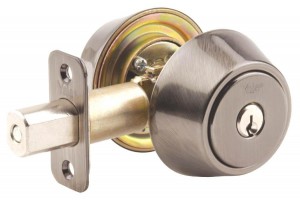Kitchener Locks History
Kitchener Locksmith (519) 489-2331
Kitchener Locks History
A locksmith’s job involves installing, fixing, picking and removing lock systems and to do so a basic understanding of how a lock works is needed. The basic system of a lock, whereby a key is used  to move a metal peg into a hole in the door frame is essentially the same across designs. However it is the manner by which this is achieved that has changed and evolved over time.
to move a metal peg into a hole in the door frame is essentially the same across designs. However it is the manner by which this is achieved that has changed and evolved over time.
In the old days, when most locks used the same gate key, this was a fairly simple matter (though the very earliest form of lock was actually found in Ancient Egypt). Gate keys, still used today though mainly as a deterrent/design feature for large gates and churches, have a very simple anatomy consisting of a blade (the actually ‘key’ bit that works with the mechanism) near the end, and a long handle which holds the blade at a right angle. This means that only a very limited number of permutations are possible, as only the distance of the blade from the end of the key and its size is what determines which lock it will fit and a persistent thief could easily replicate the key or turn the lock mechanism by other means. They are also known as warded locks and occasionally found on cupboards and drawers.
Over time however locks have become more sophisticated.
After the introduction of locksmith guilds in the middle ages, the art form progressed drastically as incidences of crime increased giving rise to a large industry. Now locksmiths were encouraged to design more and more complex designs that would be able to keep out greater numbers of intruders and be harder to pick. In order to become a ‘master locksmith’ within a guild the locksmith would have to design a new and innovative type of lock which would then be put on display within the guild or in museums. This obviously gave rise to more and more complicated types of lock.
Cylinder locks are far more common today and these work very differently.
Here the ‘cylinder’ element of the lock actually consists of a cylinder within a cylinder and it is the job of the inner chamber to turn and move the lock mechanism. Normally however this is prevented by a number of small pins of varying lengths which rest inside the chamber. It is the job of the blade of the key and its teeth then to push these pins out from the centre of the cylinder so that the lock might turn. Cylinder locks can easily be unscrewed and replaced by locksmiths if the locks need to be changed. Also popular are lever locks which utilise keys similar in design to gate keys.
Many businesses and organisations however now use digital locks with key cards or numeric coding systems to release or engage a powerful magnetic lock. These systems have the advantage of foregoing the need to copy many different keys and also negate skeleton keys or lock picks for slightly better security. On the downside they are susceptible to hacking, power outages and are fairly expensive to install.
Recent Comments